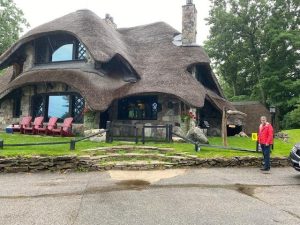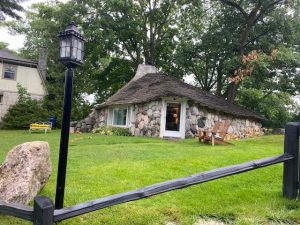Have you ever dreamed of walking through Hobbiton featured in the Lord of the Rings?
Believe it or not, you don’t need to travel to New Zealand to find Hobbit houses, the USA has our own charming town which attracts tourists from around the world.
Charlevoix is a tiny Northern Michigan town located just 4 hours north of Detroit.
Self taught builder, Earl Young built the eleven homes during the depression era, these buildings are creatively known as Gnome Homes, Mushroom Houses, or Hobbit Houses and they stand ready to transport you to middle earth.
Earl Young’s houses feature his signature designs which include wide, wavy eaves, exposed rafter tails; cedar-shake roofs; and a horizontal emphasis in design.
As an architect, Young fashioned his structures, using indigenous materials. His works are made mostly of stone, using limestone, fieldstone, and boulders that he found throughout Northern Michigan.
In all, Earl Young designed 30 unique homes over a 54 year period, 28 buildings are still standing in Charlevoix and in recent years, visitors have been drawn to the area to take a tour of the unique structures.
The self guided tour allows for easy viewing of the homes and parking is readily available on the street.
It was in this way that we set off on our own Hobbit inspired adventure.
One of the first “mushroom houses” we came upon is called the Thatch House – Formerly called Sunset Villa (pictured above). With its distinctive oversized thatched roof and lovely stonework, you can’t miss the impressive structure, located at 304 Park Avenue.
Thatched cottages are not common in the USA but with our roots in England, they are very familiar to us. There is a certain comfort which comes with seeing this particular home, which reminds me so much of the English cottages, on a grander scale.
The home was significantly remodeled in 2015, to reflect a more “mushroom” like character but it was originally built by Mr. Young in 1918. The new rendering was first drawn on a napkin. When a passerby exclaimed, “wow that looks like a mushroom”, the new owner realized the mission had been achieved. The massive home now boasts 6 bedrooms, 5 1/2 baths as well as a media room. It is used as a vacation rental and is often the setting for weddings.
Located next to the the Thatch House is the Half House.
This lovely little home appears to have been cut in half. It is said that this home was built by the imaginative Earl Young as a wedding gift for his daughter. Can you imagine receiving such a charming gift? Built in 1947, the half house remains the same as it was in its original design.
Although this house isn’t as impressive as the remodeled mushroom, it is a very large home. Viewing the house from the back reveals terraced steps which lead down from the hill above. The layers of stone have been carefully set to blend seamlessly with the landscape. This house is located at 306 Park Avenue.
The eleven mushroom houses can be found along a triangular block in the Park Avenue area consisting of Grant Street, Clinton Street and Park Avenue. This is a self guided walking tour. Parking is available along any street. The homes are now private residences, so care should be taken to respect the privacy of the owners but it is a great way to pass an hour or so.
I will leave the remaining homes for you to discover, but I’m guessing it will be easy to see why we chose “Q” as our letter to represent these “Quirky” homes.



